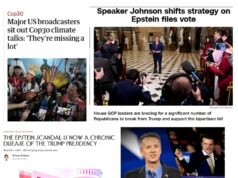The following remarks were delivered by Del. Alfonso Lopez (D-Arlington/Fairfax) to the Virginia Department of Environmental Quality at a hearing in south Alexandria a couple days ago, as well as earlier today at the EPA public comments hearing on Constitution Ave. in Washington, DC. Thanks to Del. Lopez for speaking up for our environment, and for urging action on what is arguably the most pressing problem facing mankind in the 21st century – climate change. I would hope that all Virginia Democrats – and Republicans, if they’ll come to their senses on this and stop treating it as a partisan issue – would weigh in as Del. Lopez has done, in strong support of climate action and a rapid transition from dirty to clean energy. It’s also crucial to counter garbage like this (“Fossil Fuel-Funded Groups Organizing Public Rallies Against New EPA Climate Rule”).
Despite the best efforts in some quarters to ignore it – climate change is a problem that threatens the Commonwealth of Virginia.
Whether it’s the economic repercussions of sea-level rise on Virginia’s coast-line, the health consequences of breathing polluted air, or the threat of more extreme weather conditions, climate change is having an impact on the day-to-day lives of the citizens of the Commonwealth.
At this time, Virginia’s coastal region is experiencing the highest rates of sea-level rise along the entire East Coast of the U.S. In fact, the Hampton Roads area is second only to New Orleans in its vulnerability to sea level impacts. The Norfolk-Virginia Beach Metropolitan Area is ranked 10th in flooding from sea-level rise.
We cannot afford to wait any longer to take action on climate change in VA – our economy, health, and long-term quality of life rest in the balance.
According to the most recent estimates by the CDC, 8.7 percent of Virginia’s adult population suffers from asthma. In the past three decades, the percentage of Americans with asthma has more than doubled, and climate change is putting those Americans at greater risk of landing in the hospital.
In 2012, 25 million metric tons of carbon pollution were emitted from power plants in Virginia – equal to the yearly pollution from over 5 million cars. This is unacceptable.
We have a moral obligation to address this crisis now so that we do not leave our children an environment that is polluted and damaged beyond repair.
For these reasons, I strongly urge the Virginia Department of Environmental Quality to adopt the guidelines of the President’s Clean Power Plan to address climate change in the U.S.
The EPA’s goal is to reduce nationwide carbon emissions 30% below 2005 levels by 2030. This is a reasonable and modest goal that we can help achieve by reducing carbon emissions in Virginia 38% below 2012 levels by 2030.
This goal has not been determined at random. Rather, it is based on the EPA’s analysis of Virginia’s energy profile and the potential for emissions reductions in four key “building blocks.” These building blocks are currently available in the marketplace:
1. Heat rate improvement at coal-fired power plants
2. Shifting dispatch from coal to natural gas
3. Increasing renewable and nuclear generation
4. Increasing demand-side energy efficiencyFortunately, Virginia is already working to cut emissions in these areas by increasing renewable energy generation and improving energy efficiency throughout the Commonwealth. We have a stated goal of generating 15 percent of our electricity from renewable energy by 2025.
Since 2009, the Obama Administration has supported 87 renewable energy projects in Virginia that are now generating enough energy to power more than 2,000 homes. However, we should be doing a great
deal more to expand Virginia’s solar and offshore wind capacity.Virginia is also currently working to boost energy efficiency across the Commonwealth with a goal of cutting energy waste by 10 percent in 2022 relative to 2006 levels.
Virginia’s localities are taking the initiative to increase energy efficiency as well. One example is in my home – Arlington County. The county has committed to reducing its energy intensity in public buildings 20 percent by 2020 as a part of the President’s Better Buildings Challenge.
To date, Arlington has achieved improved energy performance of 12%.
Another example is the University of Virginia, which has committed to the same goal in 15 million square feet of university buildings.
In recent years Virginia’s utility companies have also determined that it is more cost-effective to convert or shutdown 20 of their oldest and dirtiest coal-fired units. In fact, between 2008 and 2011, carbon emissions from Virginia’s power sector decreased over 20 percent.
However, while we have taken some important first steps to shrink carbon emissions in Virginia, we can and should be doing so much more to build on this momentum and reduce carbon pollution.
Luckily, the Clean Power Plan gives Virginia the flexibility and autonomy to continue our success and craft a Virginia specific plan to meet our goals.
In addition to helping avoid the negative consequences of climate change, bringing down carbon emissions will create new clean energy
jobs and grow our economy.Neighboring states have already installed solar capacity at rates 10 to 100 times higher than Virginia. This untapped solar capacity means that
there is a tremendous opportunity for Virginia to develop a robust solar energy market that will create new jobs throughout the Commonwealth.Virginia’s offshore wind resources are also abundant and unused. The build-out of our offshore wind lease area – the first such lease in the
Mid-Atlantic – could provide as many as 10,000 clean energy jobs and power 700,000 homes with pollution-free energy.Additionally, energy efficiency programs are the most cost-effective way for utility companies to meet growing demand for electricity. These
programs can also strengthen our economy by creating local jobs that cannot be outsourced.Moreover, according to Natural Resources Defense Council modeling, by 2020 alone, limits on carbon pollution could create more than 5,600 new jobs in Virginia and contribute $517 million in energy savings for Virginia households.
The solution is clear.
Implementing this proposal is an important opportunity for the Commonwealth of Virginia to address the impacts of climate change while growing our economy, creating a more sustainable energy future, and preserving our environment for future generations.
I urge DEQ and the McAuliffe Administration to give this proposal every consideration.
As a proud Member of the General Assembly, I look forward to working with you to fully enact the guidelines for President Obama’s Clean Power Plan here in Virginia.












![[UPDATED with Jim Ryan’s Letter] In Response to Youngkin’s “Sad, Whiny” Letter to Spanberger About UVA, VA Senate Majority Leader Surovell Says He’s “truly embarrassed for Gov Youngkin…After 4 yrs he has no understanding of basic VA govt structure”](https://bluevirginia.us/wp-content/uploads/2025/11/youngkinspanuva3-100x75.jpg)
